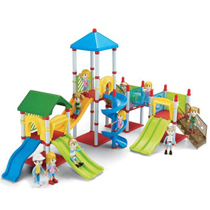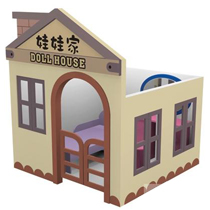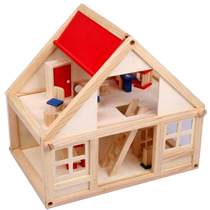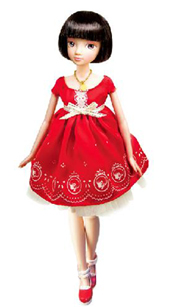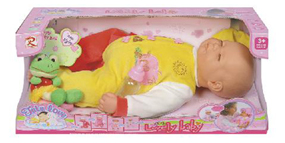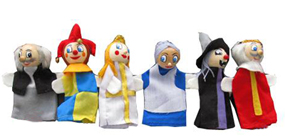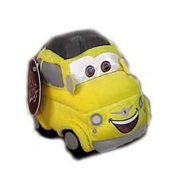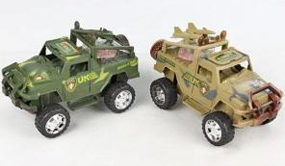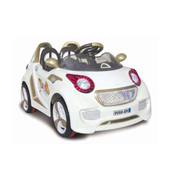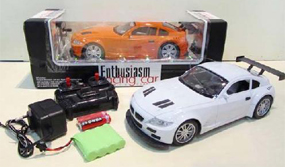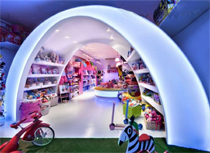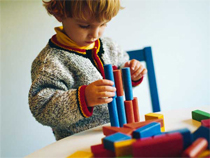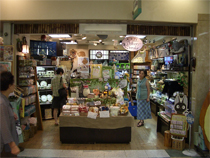 |
| A toy is any item that can be used for play. Toys are generally played with by children and pets. Playing with toys is an enjoyable means of training the young for life in society. Different materials are used to make toys enjoyable to both young and old. Many items are designed to serve as toys, but goods produced for other purposes can also be used. For instance, a small child may pick up a household item and "fly" it through the air as to pretend that it is an airplane. Another consideration is interactive digital entertainment. Some toys are produced primarily as collector's items and are intended for display only. -------------------------------------------------------------------------------------------------------------------------------------- |
Types of toys
Construction sets
|
The Greek philosopher Plato wrote that the future architect should play at building houses as a child. A construction set is a collection of separate pieces that can be joined together to create models. Popular models to make include cars, spaceships, and houses. The things that are built are sometimes used as toys once completed… view more… | ||
Dolls and miniatures
| A doll is a model of a human (often a baby), a humanoid (like Bert and Ernie), or an animal. Modern dolls are often made of cloth or plastic. Other materials that are, or have been, used in the manufacture of dolls include cornhusks, bone, stone, wood, porcelain (sometimes called china), bisque, celluloid, wax, and even apples. Often people will make dolls out of whatever materials are available to them.
| ||
Vehicles
| Children have played with miniature versions of vehicles since ancient times, with toy two-wheeled carts being depicted on ancient Greek vases. Wind-up toys have also played a part in the advancement of toy vehicles. Modern equivalents include toy cars such as those produced by Matchbox or Hot Wheels, miniature aircraft, toy boats, military vehicles, and trains. Examples of the latter range from wooden sets for younger children such as BRIO to more complicated realistic train models like those produced by Lionel, Doepke and Hornby. | ||
Puzzles
| A puzzle is a problem or enigma that challenges ingenuity. Solutions to puzzle may require recognizing patterns and creating a particular order. People with a high inductive reasoning aptitude may be better at solving these puzzles than others. Puzzles based on the process of inquiry and discovery to complete may be solved faster by those with good deduction skills. Such as: | ||
---------------------------------------------------------------------------------------------------------------------------------------
Function of toys
| | | |
| 1、Child development Toys, like play itself, serve multiple purposes in both humans and animals. They provide entertainment while fulfilling an educational role. Toys enhance cognitive behavior and stimulate creativity. They aid in the development of physical and mental skills which are necessary in later life… | ||
|
2、Gender Certain toys, such as Barbie dolls and toy soldiers, are often perceived as being more acceptable for one gender than the other. It has been noted by researchers that, "Children as young as 18 months display sex-stereotyped toy choices". However, when eye movement is tracked in young infants… | ||
|
3、Economics With toys comprising such a large and important part of human existence, it makes sense that the toy industry would have a substantial economic impact. Sales of toys often increase around holidays where gift-giving is a tradition. Some of these holidays include Christmas, Easter, Saint Nicholas Day… view more… --------------------------------------------------------------------------------------------------------------------------------------- | ||
History Of Toys
| The origin of toys is prehistoric; dolls representing infants, animals, and soldiers, as well as representations of tools used by adults are readily found at archaeological sites. The origin of the word "toy" is unknown, but it is believed that it was first used in the 14th century. The earliest toys were made from materials found in nature, such as rocks, sticks, and clay. Thousands of years ago, Egyptian children played with dolls that had wigs and movable limbs which were made from stone, pottery, and wood.In Ancient Greece and Ancient Rome, children played with dolls made of wax or terracotta, sticks, bows and arrows, and yo-yos. When Greek children, especially girls, came of age it was customary for them to sacrifice the toys of their childhood to the gods. On the eve of their wedding, young girls around fourteen would offer their dolls in a temple as a rite of passage into adulthood. As technology changed and civilization progressed, toys also changed. Where as ancient toys were made from materials found in nature like stone, wood, and grass, modern toys are often made from plastic, cloth, and synthetic materials, oftentimes powered by batteries. Ancient toys were often made by the parents and family of the children who used them, or by the children themselves. Modern toys, in contrast, are often mass-produced and sold in stores. This change in the nature of toys is exemplified by the changes that have taken place in one of the oldest and most universal of human toys; dolls. The earliest and most primitive dolls were simple wooden carvings and bundles of grass. Egyptian dolls were sometimes jointed so that their limbs could move realistically. By the early 20th century there were dolls that could say "mama". Today there are computerized dolls that can recognize and identify objects, the voice of their owner, and choose among hundreds of pre-programmed phrases with which to respond.The materials that toys are made from have changed, what toys can do has changed, but the fact that children play with toys has not changed. |
